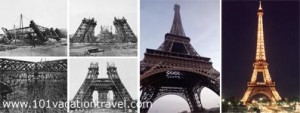Travel to Paris Eiffel Tower for Vacations

The Eiffel Tower is the best known face of Paris which is often associated with Paris, and vice versa. It is the most important structure of the 19th century that looks out across Paris. It is a world “trademark” of Paris, drawing some five million visitors each year to this city’s biggest attraction.
Back in the 19th century when plans to build a 984 foot tower in the center of Paris for the World’s Fair of 1889 became known, there were struggle at first. Architects, artists, and politicians got the “Petition of 300” together and described the plans to build what they described as a “pitch-black chimney” and a “fraud like ugliness”. Nonetheless, the tower was built in spite of these protests and subsequently contributed much to the fame of both France and Paris.
The initial plans were made by Maurice Koch, a technical assistant employed by Alexandre Gustave Eiffel’s engineering and construction company. Eiffel, a descendent of German immigrants from the Eiffel region, was awarded the lucrative contract for the World’s Fair when his company won the architectural competition held by the department of commerce.
Champs de Mars has been identified as the site for the new structure and the foundation were established in 1887. Eiffel has four huge concrete anchors, each 50 feet by 26 feet, set in the natural gravel bed of the waterside site to carry the burden of the four “elephant legs” and the entire weight of the tower of some 10,700 tons. Erection of the steel work started on July 1, 1887 to a carefully prepared plan. Workers had to join together twelve thousand separate pieces that were then partially assembled at an ironworks in Clinchy.
It was an amazing puzzle whose rise were witness by Parisians. Eiffel’s planning was so sound that he used a surplus crane to construct the lifts which take people to the viewing platforms at the heights of 187ft, 377ft, and 899ft above the ground. As the tower grew higher it cast its shadow across Paris like a sun dial but the vociferous group of protesters got smaller and smaller. The vast majority of Parisians were now acclaiming and admiring the apparent elegance of the edifice with its web-like structure which enables this colossus to give an impression of delicate tracery in spite of its significant mass.
It took about 2 years to build the Eiffel Tower. When the tower was completed on time on March 31, 1889, Eiffel had the French tricolor run up at a height of 985 feet 10 inches, newspapers celebrated the tower as a “triumph of the modern industrial culture” and as a grand secular counterpart to the Sacre-Coeur Basilica, another elevated monument that can be seen from much of Paris. From the highest observation point it was possible not just to see all of Paris but on a clear day to see far into the countryside surrounding the city.
For the opening of the World’s Fair in 1889 the steel structure that quickly became known as the Eiffel Tower was illuminated with ten thousand gas lamps which competed with the fireworks display for the Fair. Gustave Eiffel declared that for him the tower was a monument to the French Revolution of 1789 which created the conditions for “the century of industry and technique,” which was so emphatically celebrated at the World’s Fair.
In addition to great renown, the Tour Eiffel brought great financial rewards to its creator. The company owning the tower earned more than the construction costs in the first year alone. The Eiffel Tower quickly became the “trademark” of Paris and has helped to make Paris one of the most popular vacation destinations for tourists. In 1929, a radio mast was added to the top of the tower, followed in 1935 by a television transmitter, increasing the height of the tower to 1,052 feet. There is a laboratory, meteorological station, equipment for air traffic, and a small apartment on the top platform which was once used by Eiffel. There is also a restaurant on the middle platform for travelers looking for a romantic and unforgettable dining experience in Eiffel Tower itself.